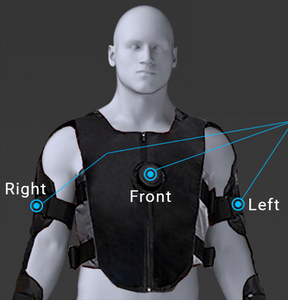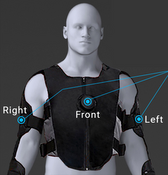Information
- Publication Type: Journal Paper (without talk)
- Workgroup(s)/Project(s): not specified
- Date: 2021
- DOI: 10.3390/electronics10222794
- Journal: Electronics
- Number: 22
- Open Access: yes
- Volume: 10
- Pages: 1 – 14
- Keywords: virtual reality, haptic feedback, tactile sensation, sound source localization, deaf and hard-of-hearing
Abstract
Sound source localization is important for spatial awareness and immersive Virtual Reality (VR) experiences. Deaf and Hard-of-Hearing (DHH) persons have limitations in completing sound-related VR tasks efficiently because they perceive audio information differently. This paper presents and evaluates a special haptic VR suit that helps DHH persons efficiently complete sound-related VR tasks. Our proposed VR suit receives sound information from the VR environment wirelessly and indicates the direction of the sound source to the DHH user by using vibrotactile feedback. Our study suggests that using different setups of the VR suit can significantly improve VR task completion times compared to not using a VR suit. Additionally, the results of mounting haptic devices on different positions of users´ bodies indicate that DHH users can complete a VR task significantly faster when two vibro-motors are mounted on their arms and ears compared to their thighs. Our quantitative and qualitative analysis demonstrates that DHH persons prefer using the system without the VR suit and prefer mounting vibro-motors in their ears. In an additional study, we did not find a significant difference in task completion time when using four vibro-motors with the VR suit compared to using only two vibro-motors in users´ ears without the VR suit.Additional Files and Images
Weblinks
- Paper link
- Entry in reposiTUm (TU Wien Publication Database)
- Entry in the publication database of TU-Wien
- DOI: 10.3390/electronics10222794
BibTeX
@article{Mirzaei_Mohhamad-2021,
title = "Effects of Using Vibrotactile Feedback on Sound Localization
by Deaf and Hard-of-Hearing People in Virtual Environments",
author = "Mohammadreza Mirzaei and Peter K\'{a}n and Hannes Kaufmann",
year = "2021",
abstract = "Sound source localization is important for spatial awareness
and immersive Virtual Reality (VR) experiences. Deaf and
Hard-of-Hearing (DHH) persons have limitations in completing
sound-related VR tasks efficiently because they perceive
audio information differently. This paper presents and
evaluates a special haptic VR suit that helps DHH persons
efficiently complete sound-related VR tasks. Our proposed VR
suit receives sound information from the VR environment
wirelessly and indicates the direction of the sound source
to the DHH user by using vibrotactile feedback. Our study
suggests that using different setups of the VR suit can
significantly improve VR task completion times compared to
not using a VR suit. Additionally, the results of mounting
haptic devices on different positions of users´ bodies
indicate that DHH users can complete a VR task significantly
faster when two vibro-motors are mounted on their arms and
ears compared to their thighs. Our quantitative and
qualitative analysis demonstrates that DHH persons prefer
using the system without the VR suit and prefer mounting
vibro-motors in their ears. In an additional study, we did
not find a significant difference in task completion time
when using four vibro-motors with the VR suit compared to
using only two vibro-motors in users´ ears without the VR
suit.",
doi = "10.3390/electronics10222794",
journal = "Electronics",
number = "22",
volume = "10",
pages = "1--14",
keywords = "virtual reality, haptic feedback, tactile sensation, sound
source localization, deaf and hard-of-hearing",
URL = "https://www.cg.tuwien.ac.at/research/publications/2021/Mirzaei_Mohhamad-2021/",
}


